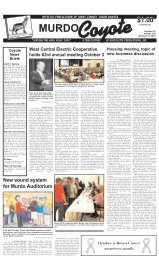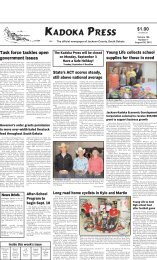Murdo E-edition.pdf - Pioneer Review
Murdo E-edition.pdf - Pioneer Review
Murdo E-edition.pdf - Pioneer Review
You also want an ePaper? Increase the reach of your titles
YUMPU automatically turns print PDFs into web optimized ePapers that Google loves.
Condition of the Winter Wheat<br />
Crop<br />
The fall of 2012 has been a challenge<br />
for South Dakota’s winter<br />
wheat producers as they faced<br />
very dry soil conditions to plant<br />
into. During the week of November<br />
25, 2012, 64 percent of winter<br />
wheat in South Dakota was rated<br />
in poor or very poor condition. This<br />
rating was the worst of any state<br />
in the primary winter wheat growing<br />
region.<br />
The quick development of<br />
severe to exceptional drought,<br />
according to the U.S. Drought<br />
Monitor (http://droughtmonitor.<br />
unl.edu/), has affected much of the<br />
wheat producing areas of the US.<br />
The winter wheat crop conditions<br />
in the central US has affected the<br />
national rating, which is now at its<br />
lowest level since records of this<br />
type began in 1986.<br />
The South Dakota Weekly Crop<br />
Weather Report, published by the<br />
National Agricultural Statistics<br />
Service puts the hard red winter<br />
wheat of South Dakota at 60 percent<br />
emerged as of 25 November.<br />
Other states have significantly<br />
better ratings, both in condition<br />
and percent emerged. Some people<br />
believe the report of 60 percent of<br />
winter wheat emerged seems high.<br />
The NASS crop progress estimates<br />
Extension News<br />
• Bob Fanning (605) 842-1267 •<br />
are based on a subjective opinion<br />
survey of county officials, which<br />
are not claimed to be statistically<br />
accurate. The important fact is<br />
that even if the figure is high, 60<br />
percent is the lowest percent of<br />
winter wheat emerged by late<br />
November in South Dakota since<br />
at least 1990. One other fall that<br />
stands out with a low percentage<br />
of winter wheat emergence in<br />
South Dakota was 2000, when 74<br />
percent of the crop was reported<br />
emerged in November. The<br />
statewide average yield in 2001<br />
was 32 Bu/acre, which tied for the<br />
second and third lowest yield since<br />
1990. It is not advisable to make<br />
yield predictions for the 2013 cropping<br />
season based on this however.<br />
Many areas where winter<br />
wheat was planted into dry soil<br />
have received small amounts of<br />
moisture via rain and/or snow.<br />
This limited moisture has caused<br />
some of the wheat to sprout, but<br />
little has actually emerged to a<br />
significant degree. These seedlings<br />
have used energy reserves from<br />
the seed, and have not been able to<br />
generate photosynthetic activity<br />
and develop crowns to store energy<br />
for winter survival. Without additional<br />
moisture, the sprouted<br />
seedlings may dry out and die.<br />
Dry soil cools off more quickly<br />
and will get colder than soil with<br />
Prepare for a healthy<br />
holiday with flu vaccination<br />
With the Christmas season and<br />
all its gatherings just around the<br />
corner, now is a good time to get a<br />
flu vaccination, says a state health<br />
official.<br />
“National Influenza Vaccination<br />
Week is December 2-8 and it’s a<br />
good reminder that getting vaccinated<br />
is the single best way to protect<br />
you and your loved ones from<br />
the flu,” said Dr. Lon Kightlinger,<br />
State Epidemiologist for the<br />
Department of Health. “Even<br />
healthy kids and adults can get<br />
very sick from the flu and its complications<br />
can lead to hospitalization<br />
and even death.”<br />
So far this flu season, South<br />
Dakota has reported 97 laboratory-confirmed<br />
cases of flu and 16<br />
flu-related hospitalizations.<br />
Kightlinger noted that not everyone<br />
who is sick seeks medical care<br />
or gets tested so the actual number<br />
of cases is higher.<br />
During the 2011-2012 season,<br />
51.1 percent of South Dakotans<br />
over age six months were vaccinated<br />
against the flu, the highest rate<br />
in the nation. “That’s good news,<br />
but there are still too many South<br />
Dakotans who don’t get vaccinated,”<br />
said Kightlinger.<br />
Annual flu vaccination is recommended<br />
for everyone, but some are<br />
at higher risk for complications –<br />
pregnant women, people over 50<br />
years and people with chronic<br />
medical conditions. Health-care<br />
workers and household contacts of<br />
high-risk populations such as<br />
those with young infants should<br />
also be vaccinated. Children are<br />
another high risk group, accounting<br />
for significant cases and hospitalizations<br />
each year and helping<br />
spread flu in the community. The<br />
department offers free flu vaccine<br />
for kids from six months to 18<br />
years.<br />
In addition to vaccination, to<br />
prevent the spread of the flu:<br />
• Wash your hands often with<br />
soap and water or use alcoholbased<br />
hand gel ;<br />
• Cover your mouth when you<br />
cough or sneeze;<br />
• Don’t touch your eyes, nose or<br />
mouth; and,<br />
• Stay home if you're sick.<br />
Learn more at http://flu.sd.gov<br />
<strong>Murdo</strong> Coyote<br />
<strong>Murdo</strong> Coyote • December 6, 2012 • Page 4<br />
adequate moisture, if low air temperatures<br />
occur without snow for<br />
insulation. This potential exposure<br />
to low temperatures could<br />
contribute to significant winterkill<br />
for a crop in marginal condition.<br />
Moisture in the form of either rain<br />
or snow would improve the condition<br />
of the crop and chances for its<br />
survival. However prospects for<br />
moisture don’t look good.<br />
Producers may want to wait<br />
before making decisions such as<br />
fertilizing until they have a better<br />
handle on the potential of the crop.<br />
As spring approaches, winter<br />
wheat growers will want to assess<br />
the condition of the crop. If the<br />
crop is insured, producers should<br />
contact their crop insurance agent<br />
before taking steps to terminate<br />
the crop and initiate alternative<br />
plans.<br />
The good news is that if the crop<br />
survives, it is almost certain that<br />
the plants will vernalize and produce<br />
a seed head. All that is necessary<br />
for the winter wheat plants to<br />
vernalize is for the kernel to take<br />
on moisture and swell, and go<br />
through a period of about three<br />
weeks at about 40 degrees or<br />
lower. It is almost unheard of for<br />
winter wheat planted in the fall in<br />
South Dakota to not complete that<br />
process. It is well known among<br />
producers that wheat, particularly<br />
winter wheat, is a tough crop and<br />
can surprise you with its resiliency.<br />
For more information, visit<br />
http://igrow.org/agronomy/wheat/.<br />
Calendar<br />
12/11/2012 – Soil Health Info Day-<br />
Davison County Extension Complex,<br />
Mitchell, SD<br />
TESTOSTERONE REPLACE-<br />
MENT THERAPY<br />
The gentleman came to the clinic<br />
to discuss one of the many television<br />
advertisements that he<br />
seen. He was 55 and wanted more<br />
information about the benefits and<br />
risks of testosterone replacement<br />
therapy. I told him this was a very<br />
complex consideration.<br />
To begin with, there is a huge<br />
variation in both the testosterone<br />
levels in the normal male population<br />
and in the response to those<br />
testosterone levels. On average, a<br />
normal male secretes 10 milligrams<br />
of testosterone per day or<br />
about 300 milligrams per month.<br />
But the body habitus of individuals<br />
in our society is variable.<br />
There are those that are short,<br />
stocky, and bald. Then there are<br />
those that are tall, thin, and still<br />
have full head of hair at 70 years<br />
of age. At least part of this difference<br />
has to do with the response to<br />
a given testosterone level that a<br />
person has in addition to whatever<br />
variability there is in the serum<br />
testosterone levels. A low blood<br />
testosterone level is a statistical<br />
number with very little meaning<br />
by itself. The importance of the<br />
testosterone level in the blood is<br />
how the person responds to it.<br />
The classical symptoms of low<br />
testosterone level include a<br />
decreased libido, a low energy<br />
level, a depressed mood, a low<br />
muscle mass, osteoporosis, erectile<br />
dysfunction and increased body<br />
fat. This is a broad and vague<br />
group of symptoms that might<br />
come from multiple different causes.<br />
When first evaluated it is<br />
important to be sure that the person’s<br />
pituitary function, thyroid<br />
function, and adrenal function are<br />
The Clinical View<br />
• Dr. P.E. Hoffsten •<br />
all normal. A routine health<br />
screening is important prior to initiating<br />
testosterone replacement<br />
therapy.<br />
If the above symptoms are present<br />
and can be shown to be associated<br />
with a low serum testosterone<br />
in the absence of other causes, the<br />
next step is to be sure that there<br />
are not contraindications to the<br />
use of testosterone replacement<br />
therapy. Among these would be<br />
breast cancer, obstructive sleep<br />
apnea, symptomatic prostate<br />
enlargement, poorly controlled<br />
heart failure, and a condition<br />
called polycythemia, meaning that<br />
more than 50 percent of the blood<br />
content is red cells. A controversial<br />
consideration has to do with<br />
whether or not the person has cancer<br />
of the prostate with a high<br />
PSA. This is listed as an absolute<br />
contraindication although some<br />
authorities do not agree with that<br />
at all.<br />
If there are no contraindications<br />
and the person would like to<br />
change the way he feels, the use of<br />
testosterone replacement therapy<br />
can be tried. By far the cheapest<br />
method is an injection given every<br />
10 days to two weeks with a product<br />
called testosterone cipionate.<br />
This is an injection of 100-200 milligrams<br />
of testosterone every 10<br />
days to two weeks. The average<br />
cost of this would be around 20<br />
dollars a month. The product that<br />
the gentleman had inquired about<br />
on television was called Axiron. It<br />
is a spray that goes into the person’s<br />
arm pits daily. The cost of<br />
this is around $375 dollars a<br />
month. Getting “preauthorization”<br />
or insurance approval is going to<br />
be an issue. There are two other<br />
products commonly used. One is<br />
called an Androderm patch in<br />
which the person puts two patches<br />
on at bedtime. This is $367 dollars<br />
a month. A product called Andro-<br />
Gel is applied to the chest and<br />
shoulders. This is $364 dollars a<br />
month. The two products as a<br />
spray and a gel carry with them<br />
the risk of rubbing some of the<br />
material off onto a female partner<br />
which may not be desired at all.<br />
The use of a pill is available overseas<br />
but the pill forms have never<br />
been felt safe and are not FDA<br />
approved for sale in the United<br />
States.<br />
A review of this topic recently<br />
appeared in the Cleveland Clinic<br />
Journal of Medicine for November<br />
of 2012. Among the clinical benefits<br />
listed in that article, is relief of<br />
all of the symptoms mentioned<br />
above. To me, the most striking<br />
clinical benefits include improvement<br />
in the metabolic syndrome.<br />
Note that the metabolic syndrome<br />
is made up of diabetes, hypertension,<br />
dyslipidemia, and obesity.<br />
Testosterone replacement therapy<br />
improved men with the metabolic<br />
syndrome by 12 weeks after starting<br />
the medication. Even more<br />
striking was there reference to a<br />
five year study demonstrating the<br />
significant longevity benefit from<br />
men using testosterone replacement<br />
therapy. Multiple small studies<br />
have demonstrated a high mortality<br />
in aged matched men with<br />
low testosterone levels.<br />
In summary, for those who have<br />
tried other methods without success,<br />
the use of testosterone therapy<br />
is reasonably priced and safe.<br />
The use of the television advertised<br />
Axiron or AndroGel or Androderm<br />
is a much more expensive<br />
undertaking.<br />
Number of homeless in South Dakota decreases<br />
On September 25, 2012, South<br />
Dakota Housing for the Homeless<br />
Consortium (SDHHC) conducted a<br />
one-day survey to identify homeless<br />
families and individuals<br />
throughout the state of South<br />
Dakota. Over the 24 hour period,<br />
1,166 individuals, including 336<br />
children, were counted, representing<br />
a 26 percent decline from the<br />
1,453 individuals identified in<br />
2011.<br />
In 2009, South Dakota received<br />
over $3.2 million in Homelessness<br />
Prevention and Rapid Re-Housing<br />
Program (HPRP) funding. The<br />
HPRP program, which ended on<br />
September 1, 2012, provided funding<br />
for rental assistance, security<br />
deposit, and utility deposits. In<br />
addition to the financial assistance,<br />
case management provided<br />
necessary services to help HPRP<br />
participants maintain housing.<br />
“Though the HPRP grant ended on<br />
September 1st, the successful<br />
results showed in our recent count.<br />
The decrease in homelessness is<br />
due largely in part to the HPRP<br />
program”, said Lisa Bondy,<br />
SDHHC Coordinator.<br />
Also, SDHHC will take the<br />
results from the 2012 count to create<br />
goals and objectives for the<br />
South Dakota’s Ten-Year Plan to<br />
End Homelessness which is currently<br />
being created.<br />
“We know that short-term assistance<br />
is not going to fix long-term<br />
barriers. The Ten-Year Plan will<br />
create specific objectives for reducing<br />
barriers for homeless individuals<br />
and families to reduce recidivism<br />
back into homelessness,” said<br />
Bondy.<br />
The statewide survey was broken<br />
down into three geographical<br />
areas according to counties: West<br />
River, East River and Central<br />
South Dakota. The Homeless<br />
Advisory Board in Sioux Falls,<br />
Black Hills Region Homeless<br />
Coalition, and South Dakota<br />
Housing Development Authority<br />
(SDHDA), were responsible for<br />
coordinating the counts.<br />
“SDHHC relies on community<br />
volunteers, law enforcement,<br />
faith-based organizations, and<br />
other agencies to help conduct the<br />
count in their areas”, said Bondy.<br />
“It is a great opportunity for agencies<br />
to come together for one specific<br />
cause to help those less fortunate<br />
in their community and to<br />
find out what barriers exist.”<br />
A few statistics from the 2012<br />
count:<br />
•Majority of homeless individuals<br />
and families were staying in<br />
emergency shelters, transitional<br />
housing or hotel/motels.<br />
•The prime reason for homelessness<br />
was Lost Job/Unemployment<br />
and Substance abuse issues;<br />
•Majority of the homeless were<br />
26-35 years of age;<br />
•Of the 1,153, 131 were sleeping<br />
outdoors the night of the count<br />
(15 of them were children)<br />
•15 percent of the homeless<br />
population were veterans<br />
•94 percent of those surveyed<br />
stated their income comes from<br />
employment<br />
•35 percent of the homeless<br />
individuals (with no family) had<br />
high school diplomas, while 20<br />
percent had some college credits<br />
•Homeless individuals, male<br />
and female, stated their need was<br />
full time employment to help them<br />
get into housing as well as assistance<br />
with first month’s rent and<br />
deposit.<br />
For more detailed results,<br />
please see our website at<br />
www.housingforthehomeless.org.<br />
Reducing the number of homeless<br />
individuals is a national and<br />
state priority. By combining the<br />
results from this count with a plan<br />
of action, SDHHC can assist its<br />
members in seeking the appropriate<br />
changes needed to address<br />
these problems. SDHHC encourages<br />
anyone who is interested in<br />
participating in this effort to<br />
please contact Lisa Bondy at<br />
South Dakota Housing Development<br />
Authority, (605) 773.3445 or<br />
lisab@sdhda.org.<br />
Are you advertising?<br />
In a tight market, keep people thinking about you,<br />
Not the Other Guy.<br />
To advertise, call the <strong>Murdo</strong> Coyote at<br />
605-669-2271

















